Strain-Balanced InAs/AlSb Type-II Superlattice Structures Growth on GaSb Substrate by Molecular Beam Epitaxy
Abstract
1. Introduction
2. Experiment
3. Results and Discussion
4. Summary
Author Contributions
Funding
Institutional Review Board Statement
Informed Consent Statement
Data Availability Statement
Conflicts of Interest
Sample Availability
Abbreviations
| MBE | Molecular Beam Epitaxy |
| T2SL | Type Two Superlattice |
| HRXRD | High Resolution X-Ray Diffraction |
| AFM | Atomic Force Microscopy |
References
- Nie, B.; Huang, J.; Zhao, C.; Huang, W.; Zhang, Y.; Cao, Y.; Ma, W. InAs/GaSb superlattice resonant tunneling diode photodetector with InAs/AlSb double barrier structure. Appl. Phys. Lett. 2019, 114, 053509. [Google Scholar] [CrossRef]
- Martyniuk, P.; Kopytko, M.; Rogalski, A. Barrier infrared detectors. Opto-Electron. Rev. 2014, 22, 127–146. [Google Scholar] [CrossRef]
- Gautam, N.; Myers, S.; Barve, A.V.; Klein, B.; Smith, E.P.; Rhiger, D.R.; Dawson, L.R.; Krishna, S. High operating temperature interband cascade midwave infrared detector based on type-II InAs/GaSb strained layer superlattice. Appl. Phys. Lett. 2012, 101, 021106. [Google Scholar] [CrossRef]
- Kroemer, H. The 6.1 A family (InAs, GaSb, AlSb) and its heterostructures: A selective review. Phys. E 2004, 20, 196–203. [Google Scholar] [CrossRef]
- Alshahrani, D.O.; Kesaria, M.; Anyebe, E.A.; Srivastava, V.; Huffaker, D.L. Emerging Type-II Superlattices of InAs/InAsSb and InAs/GaSb for Mid-Wavelength Infrared Photodetectors. Adv. Photonics Res. 2022, 3, 2100094. [Google Scholar] [CrossRef]
- Haugan, H.J.; Brown, G.J.; Grazulis, L. Effect of interfacial formation on the properties of very long wavelength infrared InAs/GaSb superlattices. J. Vac. Sci. Technol. B 2011, 29, 03C101. [Google Scholar]
- Jasik, A.; Sankowska, I.; Pierścińska, D.; Regiński, K.; Pierściński, K. Blueshift of bandgap energy and reduction of non-radiative defect density due to precise control of InAs-on-GaSb interface in type-II InAs/GaSb superlattice. J. Appl. Phys. 2011, 110, 123103. [Google Scholar] [CrossRef]
- Jasik, A.; Sankowska, I.; Regiński, K.; Machowska-Podsiadło, E.; Wawro, A.; Wzorek, M.; Kruszka, R.; Jakieła, R.; Kubacka-Traczyk, J.; Motyka, M.; et al. Crystal Growth: Theory, Mechanisms and Morphology; Nova Scicnce Publisheres, Inc.: New York, NY, USA, 2012; Volume 2, Chapter 9, pp. 293–326. [Google Scholar]
- Du, L.; Li, X.; Lou, W.; Sullivan, G.; Chang, K.; Kono, J.; Du, R.R. Evidence for a topological excitonic insulator in InAs/GaSb bilayers. Nat. Commun. 2017, 8, 1971. [Google Scholar] [CrossRef]
- Müller, R.; Haertelt, M.; Niemasz, J.; Schwarz, K.; Daumer, V.; Flores, Y.V.; Ostendorf, R.; Rehm, R. Thermoelectrically-cooled InAs/GaSb Type-II superlattice detectors as an alternative to HgCdTe in a real-time mid-infrared backscattering spectroscopy system. Micromachines 2020, 11, 1124. [Google Scholar] [CrossRef]
- Fang, S.; Hao, R.; Zhang, L.; Guo, J.; Liu, W. Simulation of the band structure of InAs/GaSb type II superlattices utilizing multiple energy band theories. Front. Phys. 2022, 10, 822800. [Google Scholar] [CrossRef]
- Zhang, Y.; Ma, W.; Cao, Y.; Huang, J.; Wei, Y.; Cui, K.; Shao, J. Long wavelength infrared InAs/GaSb superlattice photodetectors with InSb-like and mixed interfaces. IEEE J. Quantum Electron. 2011, 47, 1475. [Google Scholar] [CrossRef]
- Nicolai, J.; Warot-Fonrose, B.; Gatel, C.; Teissier, R.; Baranov, A.N.; Magen, C.; Ponchet, A. Formation of strained interfaces in AlSb/InAs multilayers grown by molecular beam epitaxy for quantum cascade lasers. J. Appl. Phys. 2015, 118, 035305. [Google Scholar] [CrossRef]
- Kubacka-Traczyk, J.; Sankowska, I.; Kaniewski, J. Interface Influence on Structural Properties of InAs/GaSb Type-II Superlattices. Opt. Appl. 2009, 39, 875–879. [Google Scholar]
- Tuttle, G.; Kroemer, H.; English, J.H. Effects of interface layer sequencing on the transport properties of InAs/AlSb quantum wells: Evidence for antisite donors at the InAs/AlSb interface. J. Appl. Phys. 1990, 67, 3032–3037. [Google Scholar] [CrossRef]
- Brar, B.; Ibbetson, J.; Kroemer, H.; English, J.H. Effects of the interface bonding type on the optical and structural properties of InAs-AlSb quantum wells. Appl. Phys. Lett. 1994, 64, 3392–3394. [Google Scholar] [CrossRef]
- Benyahia, D.; Kubiszyn, L.; Michalczewski, K.; Kębłowski, A.; Grodecki, K.; Martyniuk, P. Molecular beam epitaxy growth of InAs/AlSb superlattices on GaAs substrates. J. Cryst. Growth 2019, 522, 125–127. [Google Scholar] [CrossRef]
- Xu, Z.; Chen, J.; Wang, F.; Zhou, Y.; Jin, C.; He, L. Interface layer control and optimization of InAs/GaSb type-II superlattices grown by molecular beam epitaxy. J. Cryst. Growth 2014, 286, 220–225. [Google Scholar] [CrossRef]
- Mishra, P.; Pandey, R.K.; Kumari, S.; Pandey, A.; Dalal, S.; Sankarasubramanian, R.; Channagiri, S.; Jangir, S.K.; Raman, R.; Srinivasan, T.; et al. Interface engineered MBE grown InAs/GaSb based type-II superlattice heterostructures. J. Alloys Compd. 2021, 889, 161692. [Google Scholar] [CrossRef]
- Sankowsk, I.; Jasik, A.; Czuba, K.; Ratajczak, J.; Kozłowski, P.; Wzorek, M. A Study of Defects in InAs/GaSb Type-II Superlattices Using High-Resolution Reciprocal Space Mapping. Materials 2021, 14, 4940. [Google Scholar] [CrossRef]
- Xu, D.; Litvinchuk, A.P.; Wang, X.; Delaney, A.; Le, H.; Pei, S.S. Structure stability of short-period InAs/AlSb superlattices. J. Cryst. Growth 2003, 251, 547–550. [Google Scholar] [CrossRef]
- Zhang, Y.; Zhang, Y.; Guan, M.; Cui, L.; Li, Y.; Wang, B.; Zhu, Z.; Zeng, Y. Molecular beam epitaxial growth of AlSb/InAsSb heterostructures. Appl. Surf. Sci. 2014, 313, 479–483. [Google Scholar] [CrossRef]
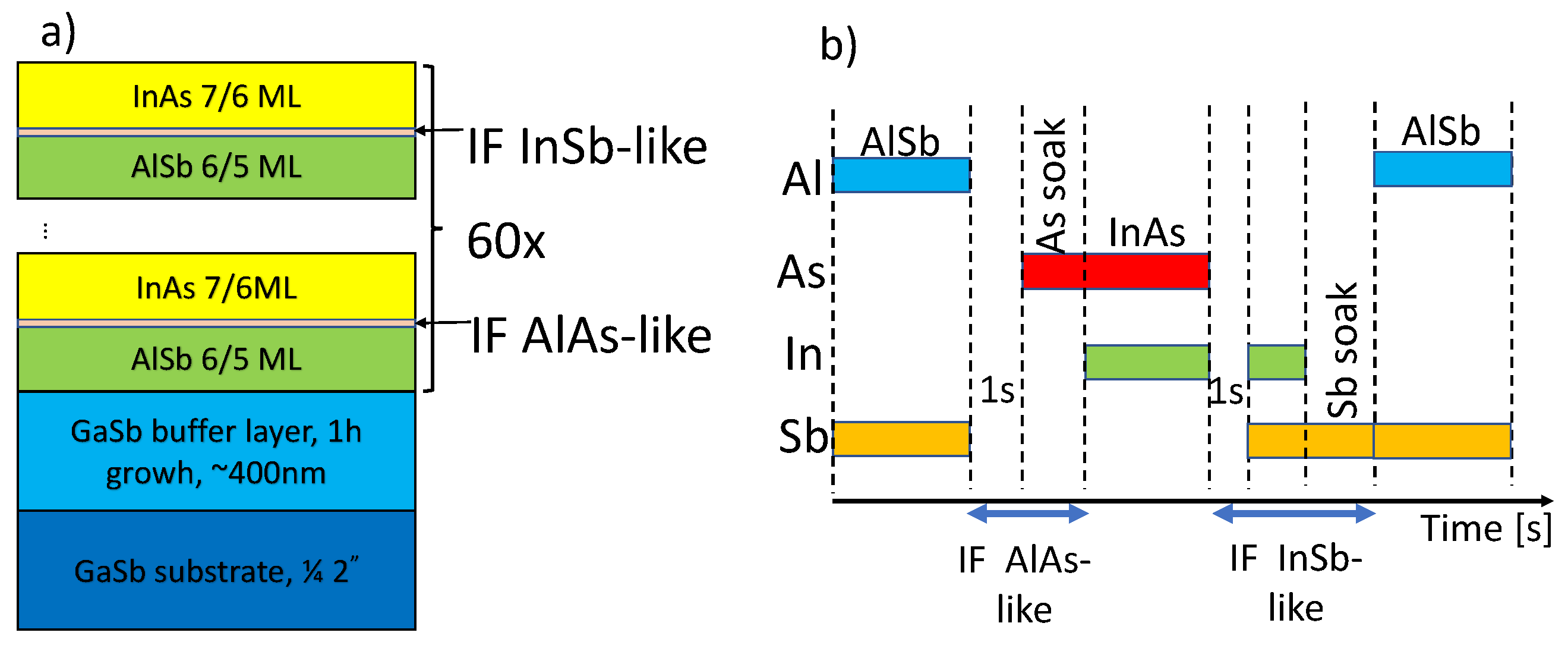
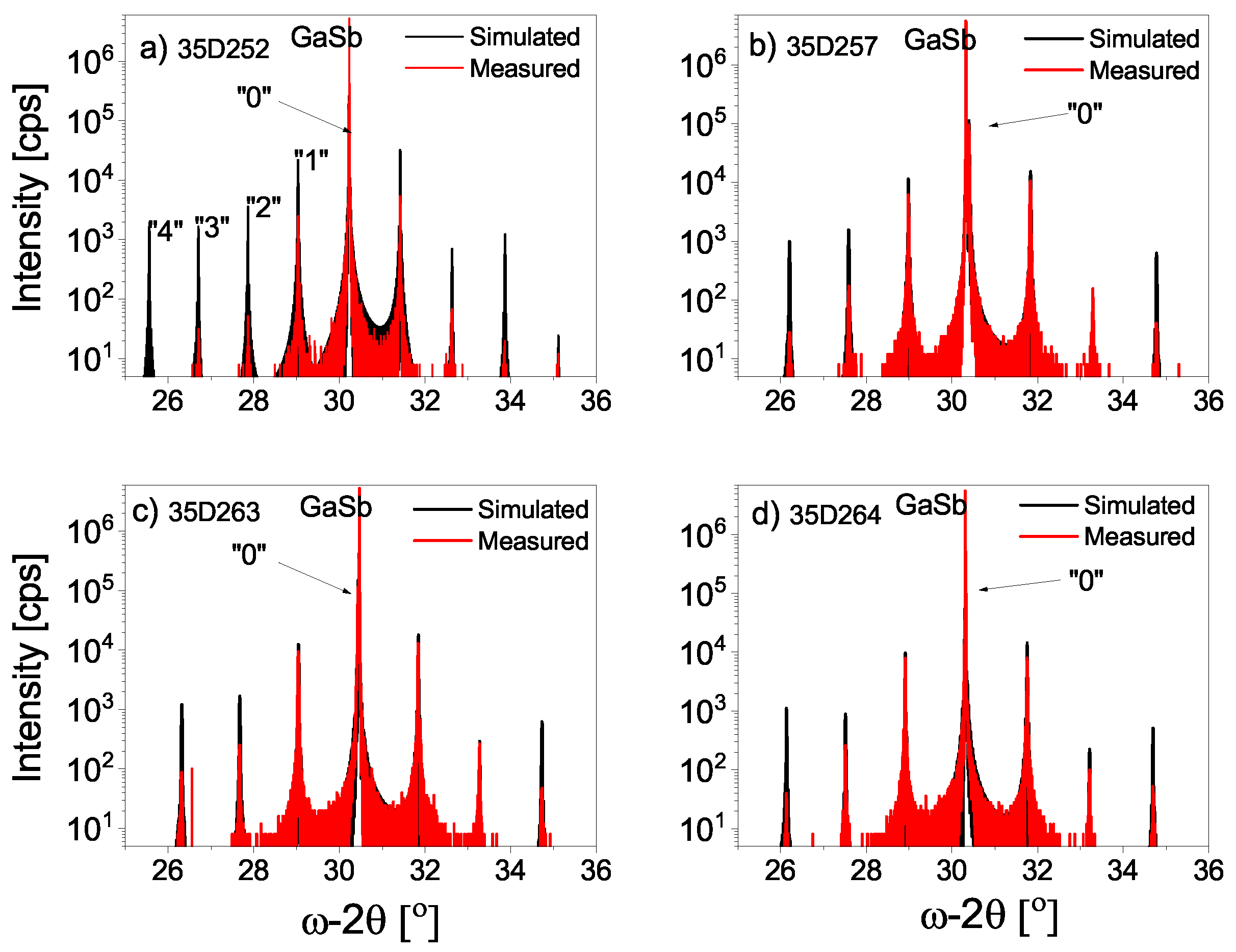
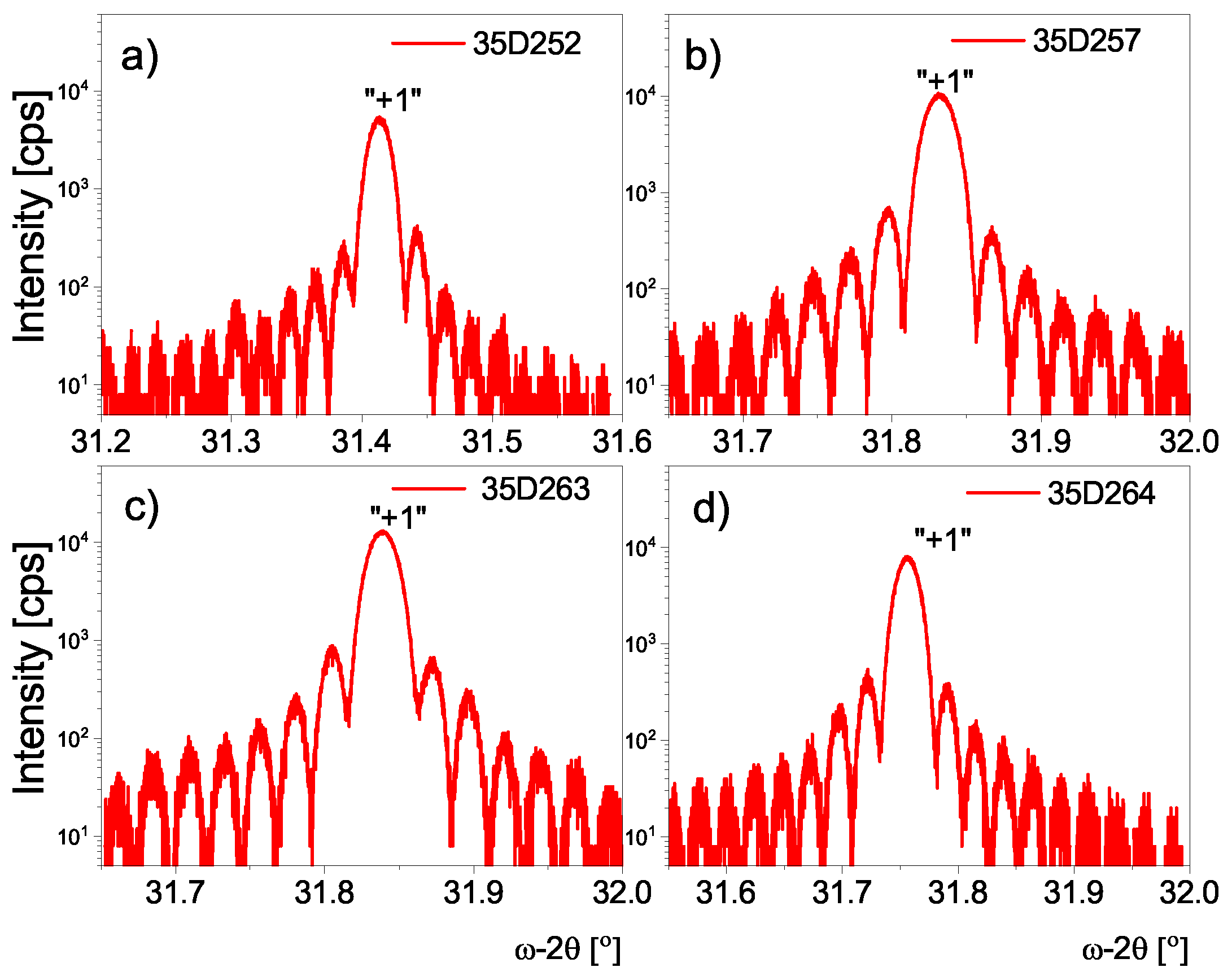
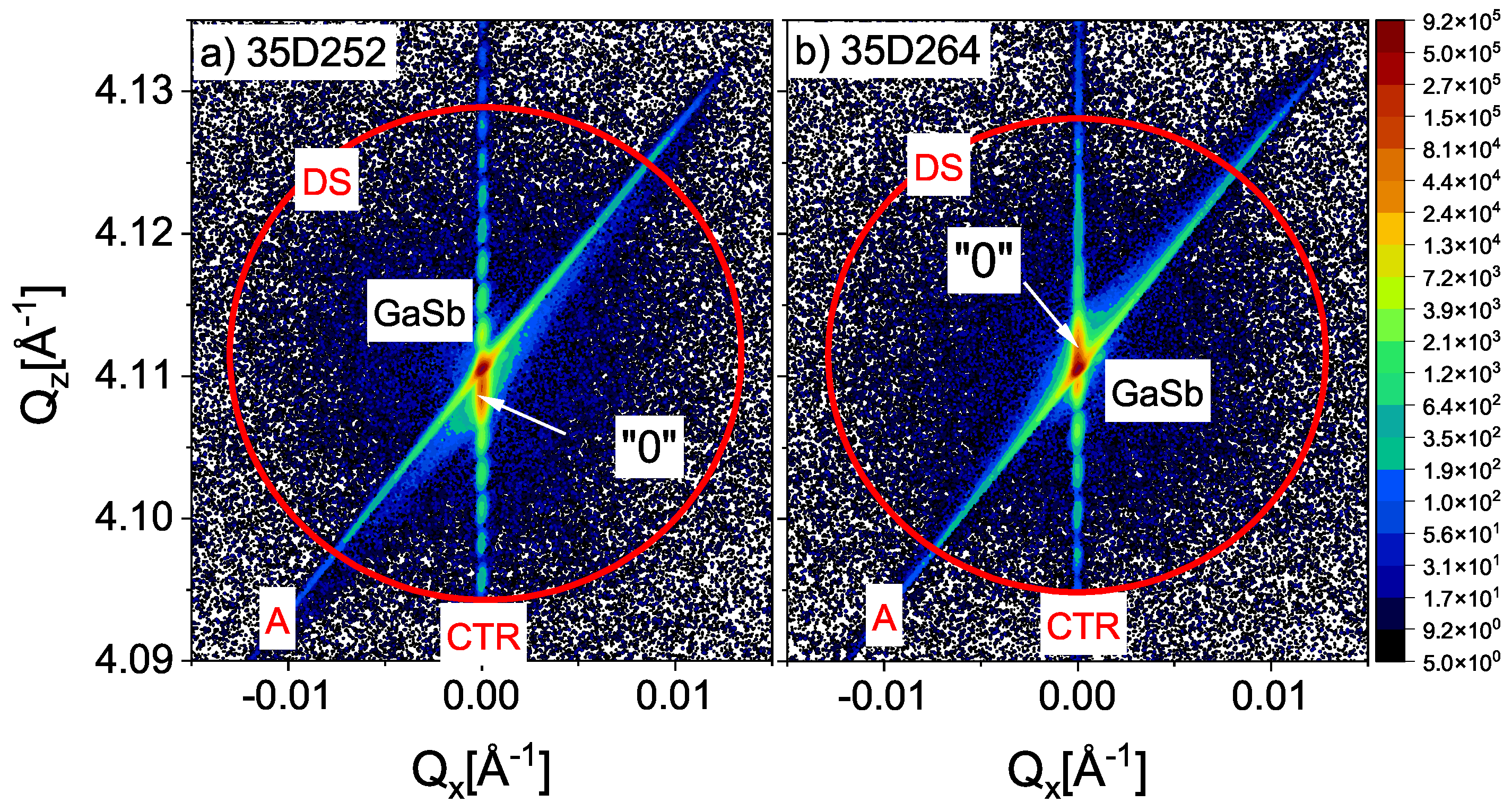
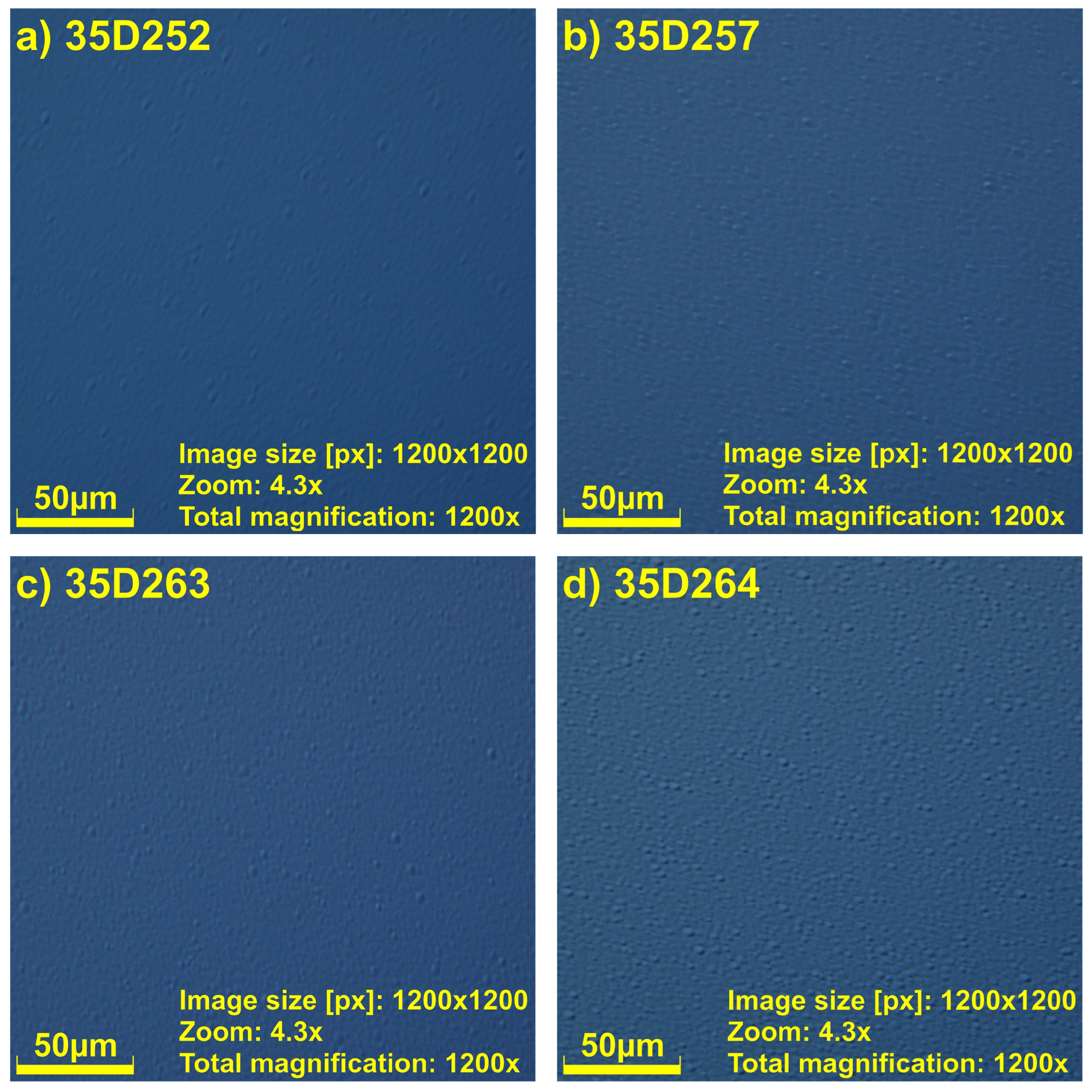
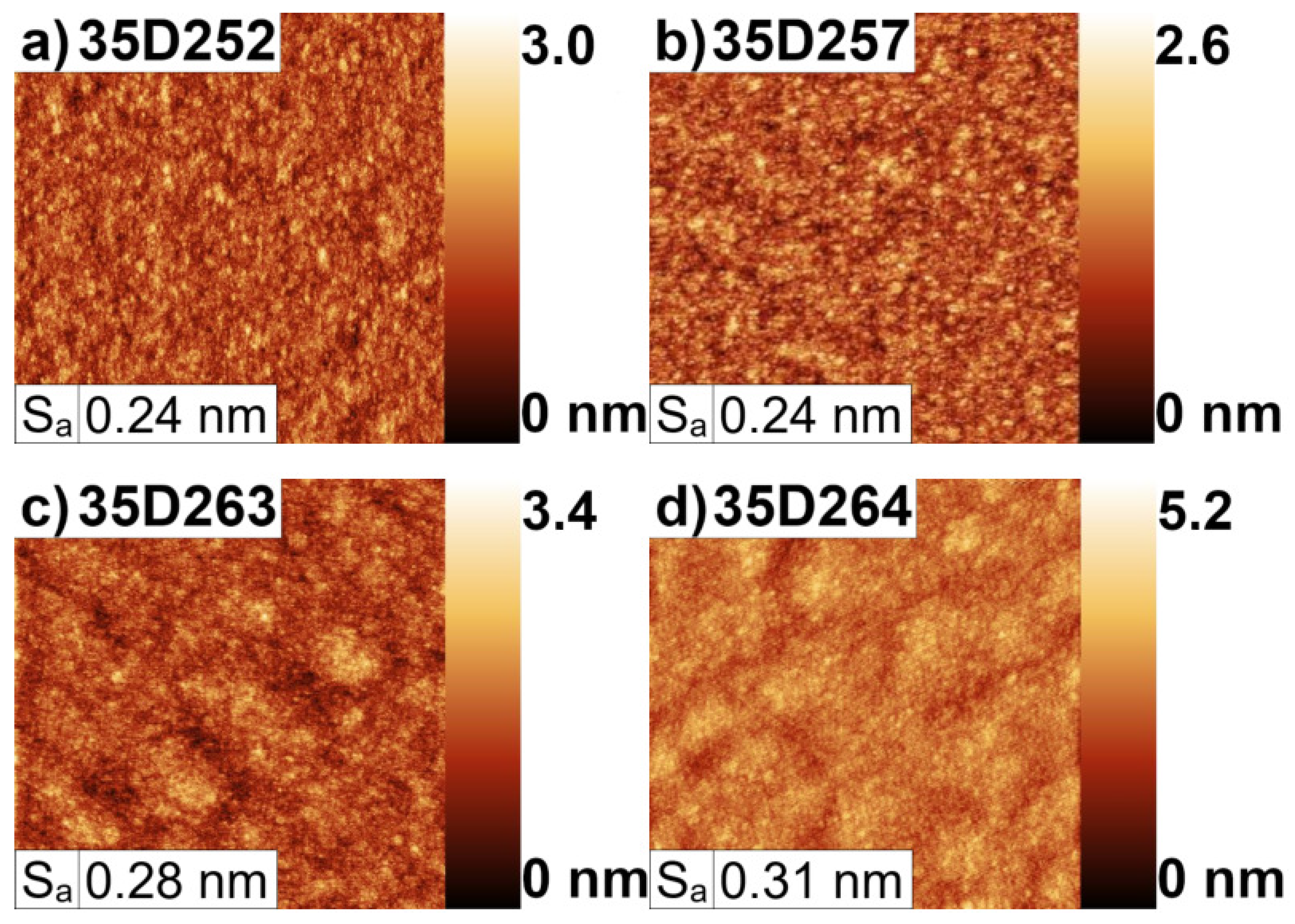
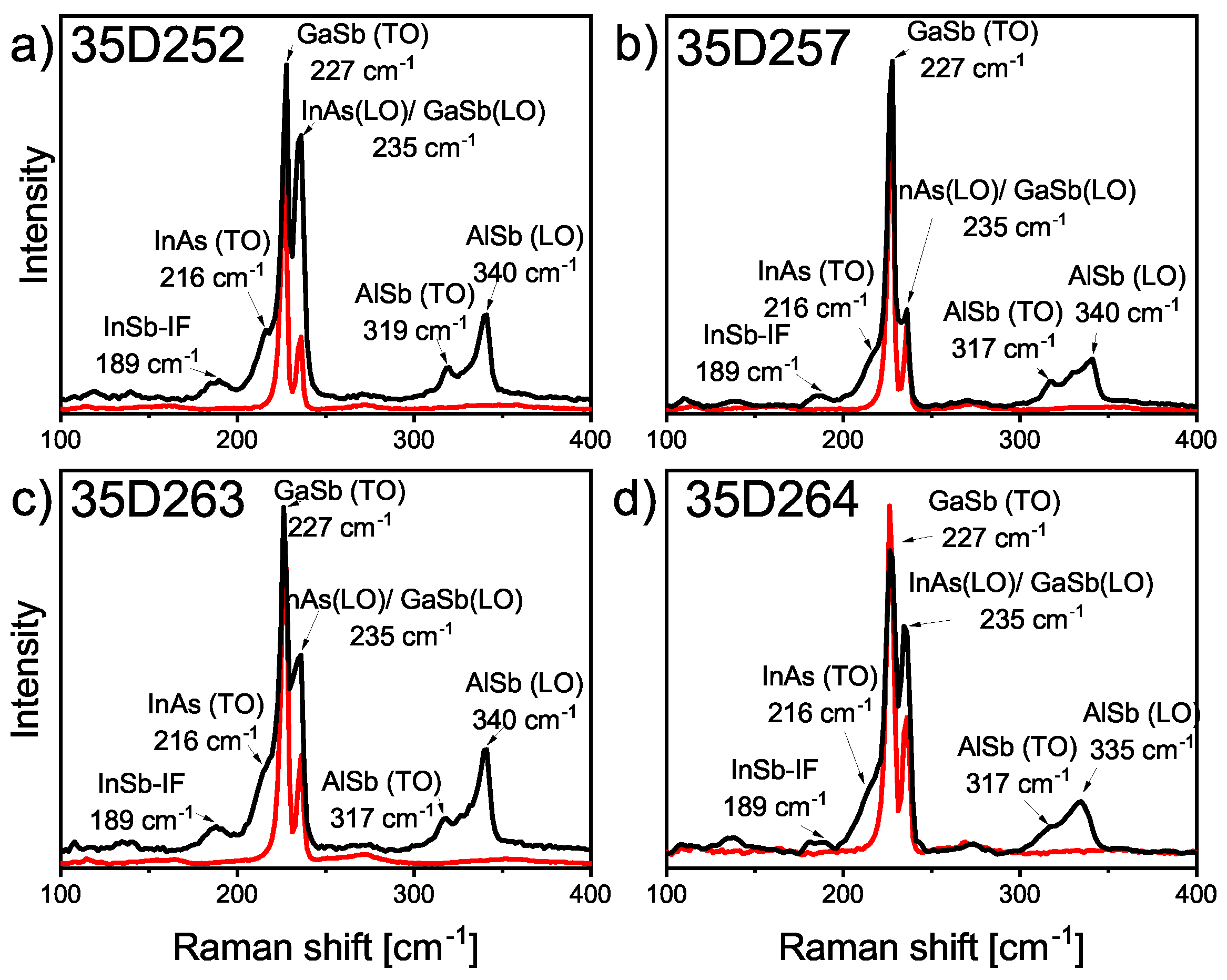
| T2SL | InAs/AlSb | IF | IFAlAs | Δa/a |
|---|---|---|---|---|
| No. | (ML)/(ML) | (ML) | (ML) | × 10 |
| 35D252 | 7.1/6.0 | 0.75 | 0.42 | 3.2 |
| 35D257 | 6.0/5.0 | 0.47 | 0.43 | 21.8 |
| 35D263 | 6.0/5.1 | 0.67 | 0.35 | 8.9 |
| 35D264 | 5.8/5.3 | 0.50 | 0.35 | 0.8 |
Disclaimer/Publisher’s Note: The statements, opinions and data contained in all publications are solely those of the individual author(s) and contributor(s) and not of MDPI and/or the editor(s). MDPI and/or the editor(s) disclaim responsibility for any injury to people or property resulting from any ideas, methods, instructions or products referred to in the content. |
© 2023 by the authors. Licensee MDPI, Basel, Switzerland. This article is an open access article distributed under the terms and conditions of the Creative Commons Attribution (CC BY) license (https://creativecommons.org/licenses/by/4.0/).
Share and Cite
Marchewka, M.; Jarosz, D.; Ruszała, M.; Juś, A.; Krzemiński, P.; Płoch, D.; Maś, K.; Wojnarowska-Nowak, R. Strain-Balanced InAs/AlSb Type-II Superlattice Structures Growth on GaSb Substrate by Molecular Beam Epitaxy. Materials 2023, 16, 1968. https://doi.org/10.3390/ma16051968
Marchewka M, Jarosz D, Ruszała M, Juś A, Krzemiński P, Płoch D, Maś K, Wojnarowska-Nowak R. Strain-Balanced InAs/AlSb Type-II Superlattice Structures Growth on GaSb Substrate by Molecular Beam Epitaxy. Materials. 2023; 16(5):1968. https://doi.org/10.3390/ma16051968
Chicago/Turabian StyleMarchewka, Michał, Dawid Jarosz, Marta Ruszała, Anna Juś, Piotr Krzemiński, Dariusz Płoch, Kinga Maś, and Renata Wojnarowska-Nowak. 2023. "Strain-Balanced InAs/AlSb Type-II Superlattice Structures Growth on GaSb Substrate by Molecular Beam Epitaxy" Materials 16, no. 5: 1968. https://doi.org/10.3390/ma16051968
APA StyleMarchewka, M., Jarosz, D., Ruszała, M., Juś, A., Krzemiński, P., Płoch, D., Maś, K., & Wojnarowska-Nowak, R. (2023). Strain-Balanced InAs/AlSb Type-II Superlattice Structures Growth on GaSb Substrate by Molecular Beam Epitaxy. Materials, 16(5), 1968. https://doi.org/10.3390/ma16051968






